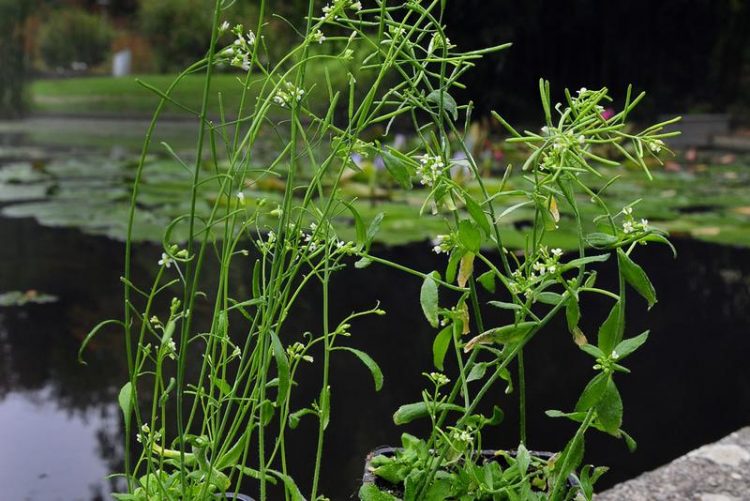How plants see light

Thale cress plant Photo: Thomas Kunz
Plants react sensitively to changes in their surroundings and possess the ability to adapt to them. They use the photoreceptor protein phytochrome B to see light and then regulate processes such as seed germination, seedling development, longitudinal growth and flower formation.
A team led by Prof. Dr. Andreas Hiltbrunner from the Institute of Biology II at the University of Freiburg has recently conducted a study that shows that both proteins PCH1 and PCHL influence this receptors’ photosensitivity. The researchers recently published their findings in the journal Nature Communications.
Phytochrome B measures the light spectrum, which varies depending on the surroundings. The protein works like a kind of switch: the bright red light of sunlight activates phytochrome B, while it is inactivated by far-red light which is abundant in canopy shade.
However, it can also switch from the active form to the inactive ground state independently of light. You would call this process dark reversion. It influences the amount of protein available in the active state, thereby affecting the plant’s light perception.
In their study, the scientists have now found out that there are two proteins in the thale cress plant, PCH1 and PCHL, which bind to phytochrome B and influence the activity of the receptor. Using a special method of spectroscopy, the researchers showed that the dark reversion of phytochrome B is almost completely suppressed when the amount of PCH1 or PCHL is increased, while the process is accelerated when PCH1 and PCHL are missing. By allowing the plants to regulate the change from the active to the inactive state, they can adapt the photosensitivity of the phytochrome B photoreceptor to different conditions.
The following were involved in the study: Beatrix Enderle, Dr. David Sheerin, Philipp Schwenk, Dr. Cornelia Klose and Prof. Dr. Andreas Hiltbrunner from the Department of Molecular Plant Physiology at the Institute of Biology II and Dr. Maximilian Ulbrich from the Department of Internal Medicine at the University Medical Center. Philipp Schwenk is a member of the Spemann Graduate School of Biology and Medicine; Andreas Hiltbrunner and Maximilian Ulbrich are members of the Freiburg Cluster of Excellence BIOSS Centre for Biological Signalling Studies.
Original publication:
Enderle, B., Sheerin, D.J., Paik, I., Kathare, P.K., Schwenk, P., Klose, C., Ulbrich, M.H., Huq, E., and Hiltbrunner, A. (2017). PCH1 and PCHL promote photomorphogenesis in plants by controlling phytochrome B dark reversion. Nature Communications 8: 2221. PubMed: https://www.ncbi.nlm.nih.gov/pubmed/29263319
Contact:
Prof. Dr. Andreas Hiltbrunner
Institute of Biology II
University of Freiburg
Tel.: 0761/203-2709
E-Mail: andreas.hiltbrunner@biologie.uni-freiburg.de
https://www.pr.uni-freiburg.de/pm-en/press-releases-2018/how-plants-see-light
Media Contact
All latest news from the category: Life Sciences and Chemistry
Articles and reports from the Life Sciences and chemistry area deal with applied and basic research into modern biology, chemistry and human medicine.
Valuable information can be found on a range of life sciences fields including bacteriology, biochemistry, bionics, bioinformatics, biophysics, biotechnology, genetics, geobotany, human biology, marine biology, microbiology, molecular biology, cellular biology, zoology, bioinorganic chemistry, microchemistry and environmental chemistry.
Newest articles

First-of-its-kind study uses remote sensing to monitor plastic debris in rivers and lakes
Remote sensing creates a cost-effective solution to monitoring plastic pollution. A first-of-its-kind study from researchers at the University of Minnesota Twin Cities shows how remote sensing can help monitor and…

Laser-based artificial neuron mimics nerve cell functions at lightning speed
With a processing speed a billion times faster than nature, chip-based laser neuron could help advance AI tasks such as pattern recognition and sequence prediction. Researchers have developed a laser-based…

Optimising the processing of plastic waste
Just one look in the yellow bin reveals a colourful jumble of different types of plastic. However, the purer and more uniform plastic waste is, the easier it is to…



